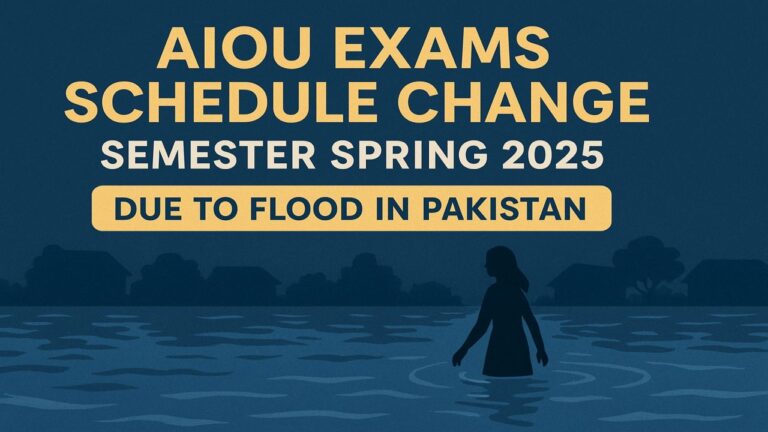1424 Code Solved Paper Autumn 2024 – Compulsory English-II
AIOU 1424 Code Solved Paper Autumn 2024: The solved paper for Course Code 1424 – Compulsory English-II for Autumn 2024 is now available for BA/BS level students. This paper is designed to help students prepare effectively for their final exams by providing accurate and well-structured answers according to the AIOU examination pattern. It covers all five questions with detailed solutions, ensuring students understand the key concepts and writing techniques required for success. With a clear medium of instruction in English, and a focus on grammar, comprehension, and composition, this solved paper is an excellent resource for revision and self-assessment.
Compulsory English II (1424) / 5411 / 9408 Solved Paper Autumn 2024
| Level | BA/BS |
|---|---|
| Semester | Autumn 2024 |
| Subject/Course Code | Compulsory English II (1424) / 5411 / 9408 |
| Maximum Marks | 100 |
| Pass Marks | 40 |
| Medium of Instruction | English |
| ATTEMPT ANY FIVE QUESTIONS. ALL CARRY EQUAL MARKS. | |
1424 Code Past Paper Autumn 2024 – Compulsory English-II

1424 Code English-II Solved Paper Autumn 2024
Question 1: Write an essay on ‘Urban Living vs. Rural Living’.
Answer:
Introduction:
The contrast between urban and rural living has long been a subject of academic and sociological interest. Both environments offer distinct lifestyles, opportunities, and challenges. Urban areas are characterized by dense populations, modern infrastructure, and diverse economic activities, while rural areas are generally marked by low population density, agricultural economies, and closer community ties. Understanding the differences between these two living environments is essential for making informed choices about residence, occupation, and lifestyle.
Urban Living:
Urban living refers to life in cities and metropolitan areas. These regions are hubs of economic development, education, healthcare, and transportation. Urban dwellers often have access to a variety of services and amenities that contribute to a fast-paced, modern lifestyle.
Advantages:
1. Better access to healthcare and education facilities
2. Greater employment opportunities across various sectors
3. Improved infrastructure including roads, public transport, and utilities
4. Exposure to diverse cultures and social experiences
Disadvantages:
1. High cost of living
2. Overcrowding and traffic congestion
3. Pollution and environmental concerns
4. Stressful and competitive lifestyle
Rural Living:
Rural living involves residing in the countryside or villages. It is often associated with agriculture, simple living, and stronger social cohesion. The lifestyle in rural areas tends to be more relaxed and closer to nature.
Advantages:
1. Peaceful and serene environment
2. Lower cost of living
3. Close-knit communities and social support
4. Access to natural surroundings and clean air
Disadvantages:
1. Limited access to healthcare and education
2. Fewer job opportunities
3. Inadequate infrastructure and public services
4. Limited entertainment and cultural activities
Comparison:
Urban and rural living offer contrasting experiences. Urban areas attract individuals seeking professional growth, convenience, and modern amenities, whereas rural regions appeal to those desiring simplicity, nature, and a slower pace of life. The choice between the two often depends on personal preferences, career goals, and family needs.
Conclusion:
Both urban and rural lifestyles have their respective strengths and weaknesses. Urban areas provide advanced facilities and dynamic opportunities but may come with stress and high expenses. In contrast, rural areas offer tranquility and affordability but often lack basic services. A balanced development approach is required to reduce disparities and ensure a higher quality of life in both settings.
Introduction:
The contrast between urban and rural living has long been a subject of academic and sociological interest. Both environments offer distinct lifestyles, opportunities, and challenges. Urban areas are characterized by dense populations, modern infrastructure, and diverse economic activities, while rural areas are generally marked by low population density, agricultural economies, and closer community ties. Understanding the differences between these two living environments is essential for making informed choices about residence, occupation, and lifestyle.
Urban Living:
Urban living refers to life in cities and metropolitan areas. These regions are hubs of economic development, education, healthcare, and transportation. Urban dwellers often have access to a variety of services and amenities that contribute to a fast-paced, modern lifestyle.
Advantages:
1. Better access to healthcare and education facilities
2. Greater employment opportunities across various sectors
3. Improved infrastructure including roads, public transport, and utilities
4. Exposure to diverse cultures and social experiences
Disadvantages:
1. High cost of living
2. Overcrowding and traffic congestion
3. Pollution and environmental concerns
4. Stressful and competitive lifestyle
Rural Living:
Rural living involves residing in the countryside or villages. It is often associated with agriculture, simple living, and stronger social cohesion. The lifestyle in rural areas tends to be more relaxed and closer to nature.
Advantages:
1. Peaceful and serene environment
2. Lower cost of living
3. Close-knit communities and social support
4. Access to natural surroundings and clean air
Disadvantages:
1. Limited access to healthcare and education
2. Fewer job opportunities
3. Inadequate infrastructure and public services
4. Limited entertainment and cultural activities
Comparison:
Urban and rural living offer contrasting experiences. Urban areas attract individuals seeking professional growth, convenience, and modern amenities, whereas rural regions appeal to those desiring simplicity, nature, and a slower pace of life. The choice between the two often depends on personal preferences, career goals, and family needs.
Conclusion:
Both urban and rural lifestyles have their respective strengths and weaknesses. Urban areas provide advanced facilities and dynamic opportunities but may come with stress and high expenses. In contrast, rural areas offer tranquility and affordability but often lack basic services. A balanced development approach is required to reduce disparities and ensure a higher quality of life in both settings.
Question 2: Write an essay on ‘Effects of Games on Studies’.
Answer:
Introduction:
Games, whether physical or digital, have become an integral part of modern youth culture. While traditionally viewed as leisure activities, games today also play a significant role in education, mental development, and social behavior. However, the influence of games on academic studies has sparked considerable debate. Some argue that games distract students from their studies, while others believe that games enhance cognitive skills and relieve academic stress. In this essay, we will explore both the positive and negative effects of games on students’ academic performance.
Positive Effects of Games on Studies:
1. Improved Cognitive Abilities:
Strategic and puzzle-based games enhance critical thinking, memory, and problem-solving skills. These mental exercises can translate into better performance in subjects like mathematics and science.
2. Enhanced Focus and Concentration:
Action or time-bound games train players to concentrate on tasks, improving their attention span. This focus can be beneficial during study sessions and exams.
3. Stress Reduction:
Studies can be overwhelming, especially during exams. Games serve as an effective stress-relief tool, helping students relax and maintain emotional balance.
4. Development of Social Skills:
Multiplayer games foster communication, teamwork, and leadership skills. These attributes are useful in classroom discussions, group assignments, and presentations.
5. Educational Value:
Many educational games are designed to teach concepts in subjects like history, language, and science through interactive learning. These make studying more engaging and effective.
Negative Effects of Games on Studies:
1. Addiction and Time Mismanagement:
One of the biggest downsides is gaming addiction. Excessive time spent on games reduces time for homework, revision, and sleep, leading to poor academic performance.
2. Decline in Academic Motivation:
Highly engaging games can make studies seem dull and uninteresting, reducing a student’s motivation to focus on academics.
3. Physical and Mental Health Issues:
Long hours of screen time can cause headaches, eye strain, and posture problems. Additionally, violent or competitive games may lead to aggression or anxiety in students.
4. Disruption of Study Routine:
Without proper time management, gaming can disrupt study schedules, making it difficult for students to maintain consistency in learning.
5. Poor Academic Results:
Students who prioritize games over studies often see a drop in grades, reduced participation in class, and incomplete assignments.
Balanced Approach:
The key to benefiting from games while maintaining good academic performance lies in balance. Parents and teachers should guide students to play games in moderation and use educational games to support learning. Time management techniques, like setting gaming limits and study schedules, can help students enjoy both games and studies without conflict.
Conclusion:
Games can have both beneficial and harmful effects on studies, depending on how they are used. When played responsibly, games can enhance mental agility, reduce stress, and even support learning. However, when misused or played excessively, they can become a major hindrance to academic success. Therefore, students should adopt a disciplined approach, ensuring that games remain a source of recreation rather than a distraction from their academic goals.
Introduction:
Games, whether physical or digital, have become an integral part of modern youth culture. While traditionally viewed as leisure activities, games today also play a significant role in education, mental development, and social behavior. However, the influence of games on academic studies has sparked considerable debate. Some argue that games distract students from their studies, while others believe that games enhance cognitive skills and relieve academic stress. In this essay, we will explore both the positive and negative effects of games on students’ academic performance.
Positive Effects of Games on Studies:
1. Improved Cognitive Abilities:
Strategic and puzzle-based games enhance critical thinking, memory, and problem-solving skills. These mental exercises can translate into better performance in subjects like mathematics and science.
2. Enhanced Focus and Concentration:
Action or time-bound games train players to concentrate on tasks, improving their attention span. This focus can be beneficial during study sessions and exams.
3. Stress Reduction:
Studies can be overwhelming, especially during exams. Games serve as an effective stress-relief tool, helping students relax and maintain emotional balance.
4. Development of Social Skills:
Multiplayer games foster communication, teamwork, and leadership skills. These attributes are useful in classroom discussions, group assignments, and presentations.
5. Educational Value:
Many educational games are designed to teach concepts in subjects like history, language, and science through interactive learning. These make studying more engaging and effective.
Negative Effects of Games on Studies:
1. Addiction and Time Mismanagement:
One of the biggest downsides is gaming addiction. Excessive time spent on games reduces time for homework, revision, and sleep, leading to poor academic performance.
2. Decline in Academic Motivation:
Highly engaging games can make studies seem dull and uninteresting, reducing a student’s motivation to focus on academics.
3. Physical and Mental Health Issues:
Long hours of screen time can cause headaches, eye strain, and posture problems. Additionally, violent or competitive games may lead to aggression or anxiety in students.
4. Disruption of Study Routine:
Without proper time management, gaming can disrupt study schedules, making it difficult for students to maintain consistency in learning.
5. Poor Academic Results:
Students who prioritize games over studies often see a drop in grades, reduced participation in class, and incomplete assignments.
Balanced Approach:
The key to benefiting from games while maintaining good academic performance lies in balance. Parents and teachers should guide students to play games in moderation and use educational games to support learning. Time management techniques, like setting gaming limits and study schedules, can help students enjoy both games and studies without conflict.
Conclusion:
Games can have both beneficial and harmful effects on studies, depending on how they are used. When played responsibly, games can enhance mental agility, reduce stress, and even support learning. However, when misused or played excessively, they can become a major hindrance to academic success. Therefore, students should adopt a disciplined approach, ensuring that games remain a source of recreation rather than a distraction from their academic goals.
Question 3: Differentiate between Denotative and Connotative meaning of words by giving 10 examples
from day to day life.
Answer:
Definition:
Denotative Meaning: The denotative meaning of a word is its literal, dictionary definition without any emotional or cultural associations.
Connotative Meaning: The connotative meaning of a word includes the emotional, cultural, or suggestive meanings that a word implies in a specific context.
Examples:
1. Snake
Denotative: A legless, cold-blooded reptile.
Connotative: A treacherous or deceitful person.
2. Home
Denotative: A building where one lives.
Connotative: A place of comfort, warmth, and belonging.
3. Childish
Denotative: Related to a child.
Connotative: Immature or silly behavior.
4. Rose
Denotative: A type of flower.
Connotative: Symbol of love or romance.
5. Cheap
Denotative: Low in cost.
Connotative: Poor in quality or lacking value.
6. Dove
Denotative: A type of bird.
Connotative: A symbol of peace and innocence.
7. Mother
Denotative: A female parent.
Connotative: A symbol of care, sacrifice, and unconditional love.
8. Fire
Denotative: A process of combustion producing heat and light.
Connotative: Passion, anger, or destruction.
9. Youth
Denotative: The period between childhood and adulthood.
Connotative: Energy, hope, inexperience, or rebellion.
10. Storm
Denotative: A violent weather condition with wind and rain.
Connotative: Emotional turmoil or sudden trouble.
Conclusion:
Understanding both denotative and connotative meanings is essential for effective communication. While denotations provide clarity, connotations add depth, emotion, and cultural relevance to language.
Definition:
Denotative Meaning: The denotative meaning of a word is its literal, dictionary definition without any emotional or cultural associations.
Connotative Meaning: The connotative meaning of a word includes the emotional, cultural, or suggestive meanings that a word implies in a specific context.
Examples:
1. Snake
Denotative: A legless, cold-blooded reptile.
Connotative: A treacherous or deceitful person.
2. Home
Denotative: A building where one lives.
Connotative: A place of comfort, warmth, and belonging.
3. Childish
Denotative: Related to a child.
Connotative: Immature or silly behavior.
4. Rose
Denotative: A type of flower.
Connotative: Symbol of love or romance.
5. Cheap
Denotative: Low in cost.
Connotative: Poor in quality or lacking value.
6. Dove
Denotative: A type of bird.
Connotative: A symbol of peace and innocence.
7. Mother
Denotative: A female parent.
Connotative: A symbol of care, sacrifice, and unconditional love.
8. Fire
Denotative: A process of combustion producing heat and light.
Connotative: Passion, anger, or destruction.
9. Youth
Denotative: The period between childhood and adulthood.
Connotative: Energy, hope, inexperience, or rebellion.
10. Storm
Denotative: A violent weather condition with wind and rain.
Connotative: Emotional turmoil or sudden trouble.
Conclusion:
Understanding both denotative and connotative meanings is essential for effective communication. While denotations provide clarity, connotations add depth, emotion, and cultural relevance to language.
Question 4: Correct the following sentences:
1. Ali finished his work one day before.
2. Muhammad Saif is a honest person.
3. He is reading his favorite book for last two hours.
4. My mother will has reached her destination by April 2025.
5. Ali & Akbar are going to launching a new car.
6. He knows to play football.
7. He is beating itself with a stick.
8. Rich should help poor.
9. What is time on your watch?
10. He is entitled of ten thousand rupees.
1. Ali finished his work one day before.
2. Muhammad Saif is a honest person.
3. He is reading his favorite book for last two hours.
4. My mother will has reached her destination by April 2025.
5. Ali & Akbar are going to launching a new car.
6. He knows to play football.
7. He is beating itself with a stick.
8. Rich should help poor.
9. What is time on your watch?
10. He is entitled of ten thousand rupees.
Answer:
1. Incorrect: Ali finished his work one day before.
Correct: Ali finished his work a day earlier.
2. Incorrect: Muhammad Saif is a honest person.
Correct: Muhammad Saif is an honest person.
3. Incorrect: He is reading his favorite book for last two hours.
Correct: He has been reading his favorite book for the last two hours.
4. Incorrect: My mother will has reached her destination by April 2025.
Correct: My mother will have reached her destination by April 2025.
5. Incorrect: Ali & Akbar are going to launching a new car.
Correct: Ali & Akbar are going to launch a new car.
6. Incorrect: He knows to play football.
Correct: He knows how to play football.
7. Incorrect: He is beating itself with a stick.
Correct: He is beating himself with a stick.
8. Incorrect: Rich should help poor.
Correct: The rich should help the poor.
9. Incorrect: What is time on your watch?
Correct: What time is it on your watch?
10. Incorrect: He is entitled of ten thousand rupees.
Correct: He is entitled to ten thousand rupees.
Conclusion:
Correct grammar and sentence structure are essential for clear communication. The corrections above improve clarity, accuracy, and proper usage of tenses, articles, and idiomatic expressions.
1. Incorrect: Ali finished his work one day before.
Correct: Ali finished his work a day earlier.
2. Incorrect: Muhammad Saif is a honest person.
Correct: Muhammad Saif is an honest person.
3. Incorrect: He is reading his favorite book for last two hours.
Correct: He has been reading his favorite book for the last two hours.
4. Incorrect: My mother will has reached her destination by April 2025.
Correct: My mother will have reached her destination by April 2025.
5. Incorrect: Ali & Akbar are going to launching a new car.
Correct: Ali & Akbar are going to launch a new car.
6. Incorrect: He knows to play football.
Correct: He knows how to play football.
7. Incorrect: He is beating itself with a stick.
Correct: He is beating himself with a stick.
8. Incorrect: Rich should help poor.
Correct: The rich should help the poor.
9. Incorrect: What is time on your watch?
Correct: What time is it on your watch?
10. Incorrect: He is entitled of ten thousand rupees.
Correct: He is entitled to ten thousand rupees.
Conclusion:
Correct grammar and sentence structure are essential for clear communication. The corrections above improve clarity, accuracy, and proper usage of tenses, articles, and idiomatic expressions.
Question 5: Read the passage and answer the questions given at the end.
The age of steam has yielded place to the age of electricity. We have harnessed and introduced it into the service of man. The electric telegraph bears our message and brings us news from all quarters of the world. Submarine cable does its own work all right. Who is not familiar with the electric bell? Who has not used telephone? Who is not enjoying electric light? Electric motors, wireless telegraphy, electric railways, electric modes of constructions and destruction all attest to the great power of electricity. Electricity has developed modern industry and has created many new industries. It has enabled man to conquer land, the sea, and the air.
Questions:
1. Why do we call the present age the age of electricity?
2. Which age has yielded place to the age of electricity?
3. How do we send and receive messages?
4. State some important uses of electricity?
5. What do you think is the future of electricity?
The age of steam has yielded place to the age of electricity. We have harnessed and introduced it into the service of man. The electric telegraph bears our message and brings us news from all quarters of the world. Submarine cable does its own work all right. Who is not familiar with the electric bell? Who has not used telephone? Who is not enjoying electric light? Electric motors, wireless telegraphy, electric railways, electric modes of constructions and destruction all attest to the great power of electricity. Electricity has developed modern industry and has created many new industries. It has enabled man to conquer land, the sea, and the air.
Questions:
1. Why do we call the present age the age of electricity?
2. Which age has yielded place to the age of electricity?
3. How do we send and receive messages?
4. State some important uses of electricity?
5. What do you think is the future of electricity?
Answer:
1. Why do we call the present age the age of electricity?
We call the present age the age of electricity because electricity is widely used in almost every aspect of our daily lives and industries. It powers communication devices like telegraphs and telephones, lights our homes, and drives modern machines and transport. It has revolutionized human life and industry.
2. Which age has yielded place to the age of electricity?
The age of steam has yielded place to the age of electricity.
3. How do we send and receive messages?
We send and receive messages through the electric telegraph, telephone, and submarine cables, which transmit information quickly across long distances.
4. State some important uses of electricity?
Important uses of electricity include electric bells, telephones, electric lights, electric motors, wireless telegraphy, electric railways, and various machines used in construction and destruction.
5. What do you think is the future of electricity?
The future of electricity is very promising. It will continue to advance technology, improve communication, increase industrial production, and help mankind explore new frontiers such as space travel. Electricity will remain the backbone of future innovation and development.
Conclusion:
Electricity has transformed the modern world, replacing older technologies and enabling tremendous progress. Its importance will only grow as new technologies evolve.
1. Why do we call the present age the age of electricity?
We call the present age the age of electricity because electricity is widely used in almost every aspect of our daily lives and industries. It powers communication devices like telegraphs and telephones, lights our homes, and drives modern machines and transport. It has revolutionized human life and industry.
2. Which age has yielded place to the age of electricity?
The age of steam has yielded place to the age of electricity.
3. How do we send and receive messages?
We send and receive messages through the electric telegraph, telephone, and submarine cables, which transmit information quickly across long distances.
4. State some important uses of electricity?
Important uses of electricity include electric bells, telephones, electric lights, electric motors, wireless telegraphy, electric railways, and various machines used in construction and destruction.
5. What do you think is the future of electricity?
The future of electricity is very promising. It will continue to advance technology, improve communication, increase industrial production, and help mankind explore new frontiers such as space travel. Electricity will remain the backbone of future innovation and development.
Conclusion:
Electricity has transformed the modern world, replacing older technologies and enabling tremendous progress. Its importance will only grow as new technologies evolve.
Question 6: You are Editor of a prominent English Daily. Write an editorial about the current
political situation in the country. Critically analyse the political tension. Present your position as a senior
analyst how the situation can be improved to bring stability in the country.
Answer:
Editorial: Navigating the Political Crossroads for National Stability
The current political situation in our country is marked by deep tensions and uncertainties that are affecting not only governance but the very fabric of our society. Political factions have entrenched themselves in rigid positions, often prioritizing partisan gains over national interest. This has resulted in frequent protests, legislative deadlocks, and a growing sense of disillusionment among the citizens.
At the heart of this political unrest lie unresolved issues such as governance inefficiencies, corruption allegations, and economic challenges. The political leadership has struggled to foster dialogue and compromise, instead engaging in blame games and confrontations. This environment has hindered effective policy-making, impacting economic growth, investment, and public trust.
As a senior analyst and editor, it is clear that the path to stability requires a multi-faceted approach. First, political leaders must embrace constructive dialogue and transparent communication, moving beyond personal agendas. Establishing inclusive platforms where all stakeholders — including opposition parties, civil society, and the youth — can voice concerns and contribute ideas is essential.
Second, strengthening institutions to ensure accountability and rule of law will rebuild public confidence. Judicial independence and impartial media play crucial roles in checking abuses of power and promoting transparency.
Third, addressing socio-economic disparities by implementing effective development programs will alleviate frustrations that often fuel political unrest. The government should prioritize education, healthcare, and job creation to foster social cohesion.
In conclusion, while the current political situation presents significant challenges, it also offers an opportunity for transformative change. Stability is attainable if political actors rise above short-term rivalries, prioritizing the nation’s well-being. The future depends on collaborative leadership, strong institutions, and an engaged citizenry committed to democratic principles.
Only through unity and constructive efforts can we hope to build a stable and prosperous country for generations to come.
Editorial: Navigating the Political Crossroads for National Stability
The current political situation in our country is marked by deep tensions and uncertainties that are affecting not only governance but the very fabric of our society. Political factions have entrenched themselves in rigid positions, often prioritizing partisan gains over national interest. This has resulted in frequent protests, legislative deadlocks, and a growing sense of disillusionment among the citizens.
At the heart of this political unrest lie unresolved issues such as governance inefficiencies, corruption allegations, and economic challenges. The political leadership has struggled to foster dialogue and compromise, instead engaging in blame games and confrontations. This environment has hindered effective policy-making, impacting economic growth, investment, and public trust.
As a senior analyst and editor, it is clear that the path to stability requires a multi-faceted approach. First, political leaders must embrace constructive dialogue and transparent communication, moving beyond personal agendas. Establishing inclusive platforms where all stakeholders — including opposition parties, civil society, and the youth — can voice concerns and contribute ideas is essential.
Second, strengthening institutions to ensure accountability and rule of law will rebuild public confidence. Judicial independence and impartial media play crucial roles in checking abuses of power and promoting transparency.
Third, addressing socio-economic disparities by implementing effective development programs will alleviate frustrations that often fuel political unrest. The government should prioritize education, healthcare, and job creation to foster social cohesion.
In conclusion, while the current political situation presents significant challenges, it also offers an opportunity for transformative change. Stability is attainable if political actors rise above short-term rivalries, prioritizing the nation’s well-being. The future depends on collaborative leadership, strong institutions, and an engaged citizenry committed to democratic principles.
Only through unity and constructive efforts can we hope to build a stable and prosperous country for generations to come.
Question 7: Write neutral & negative meaning/words against the following words:
Answer:
| Word | Neutral Meaning/Word | Negative Meaning/Word |
|---|---|---|
| 1. Bold | Confident | Reckless |
| 2. Brilliant | Intelligent | Arrogant |
| 3. Broad-minded | Open-minded | Indecisive |
| 4. Committed | Dedicated | Obsessive |
| 5. Constructive | Helpful | Critical |
| 6. Creative | Innovative | Unrealistic |
| 7. Determined | Resolute | Stubborn |
| 8. Excellent | Very good | Pompous |
| 9. Motivated | Driven | Pressured |
| 10. Neat | Organized | Overly meticulous |
Question 8: What are your favourite two countries? Your answer must include the techniques of
‘Comparison & Contrast’.
Answer:
My two favourite countries are Japan and Canada. Both countries are famous for their natural beauty and high quality of life, yet they differ greatly in culture, climate, and lifestyle.
Comparison:
Both Japan and Canada are known for their cleanliness, advanced technology, and strong education systems. People in both countries value respect, politeness, and community harmony. Additionally, both countries offer excellent healthcare facilities and safety for their citizens.
Contrast:
Despite these similarities, Japan and Canada have very different climates. Japan experiences four distinct seasons, including hot summers and cold winters with snowfall in many regions. In contrast, Canada is known for its long and harsh winters, especially in the northern parts, and milder summers.
Culturally, Japan has a rich history deeply rooted in traditions such as tea ceremonies, calligraphy, and martial arts. Its society is more collectivist, focusing on group harmony and social order. On the other hand, Canada is a multicultural and diverse country, welcoming people from all over the world. Its culture encourages individual freedom and celebrates diversity.
Lifestyle-wise, Japanese cities are densely populated with efficient public transport, while Canada offers more open spaces and nature, attracting those who enjoy outdoor activities like hiking and skiing.
Conclusion:
Both Japan and Canada offer unique experiences and advantages. Japan’s rich culture and advanced urban life contrast with Canada’s vast natural beauty and multicultural society. My preference depends on the occasion—Japan for cultural exploration and innovation, and Canada for peace, nature, and diversity.
My two favourite countries are Japan and Canada. Both countries are famous for their natural beauty and high quality of life, yet they differ greatly in culture, climate, and lifestyle.
Comparison:
Both Japan and Canada are known for their cleanliness, advanced technology, and strong education systems. People in both countries value respect, politeness, and community harmony. Additionally, both countries offer excellent healthcare facilities and safety for their citizens.
Contrast:
Despite these similarities, Japan and Canada have very different climates. Japan experiences four distinct seasons, including hot summers and cold winters with snowfall in many regions. In contrast, Canada is known for its long and harsh winters, especially in the northern parts, and milder summers.
Culturally, Japan has a rich history deeply rooted in traditions such as tea ceremonies, calligraphy, and martial arts. Its society is more collectivist, focusing on group harmony and social order. On the other hand, Canada is a multicultural and diverse country, welcoming people from all over the world. Its culture encourages individual freedom and celebrates diversity.
Lifestyle-wise, Japanese cities are densely populated with efficient public transport, while Canada offers more open spaces and nature, attracting those who enjoy outdoor activities like hiking and skiing.
Conclusion:
Both Japan and Canada offer unique experiences and advantages. Japan’s rich culture and advanced urban life contrast with Canada’s vast natural beauty and multicultural society. My preference depends on the occasion—Japan for cultural exploration and innovation, and Canada for peace, nature, and diversity.
















2 Comments
Bss yahi karny ha
g yahi kr lo and past papers ka solution bi kr lo. apka paper zabardast ho jy ga